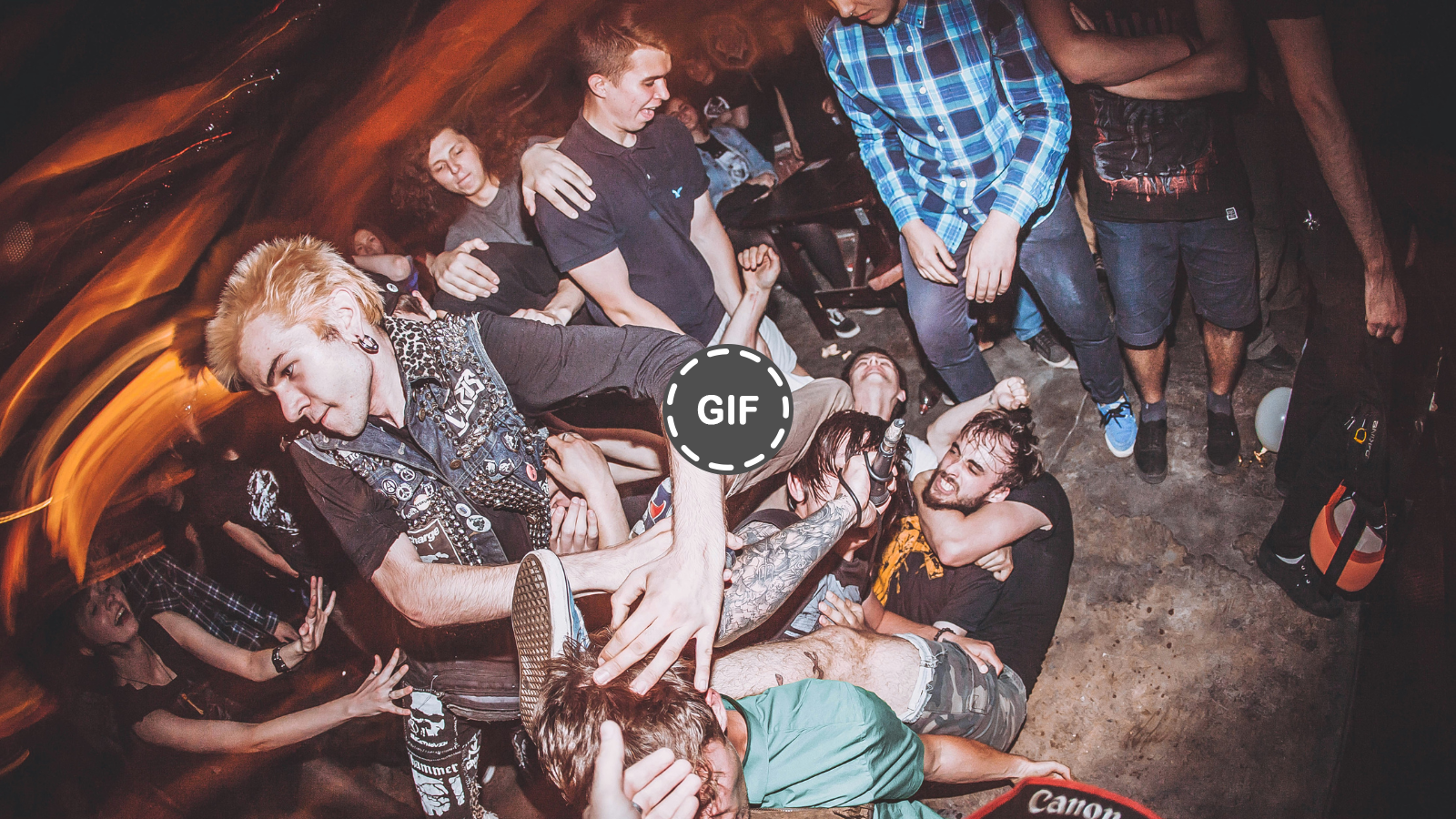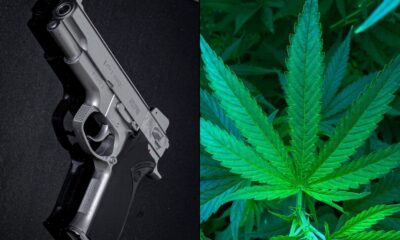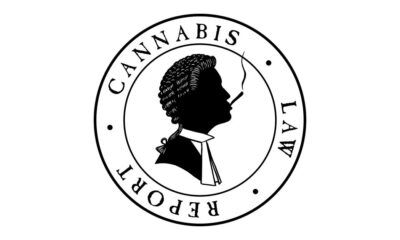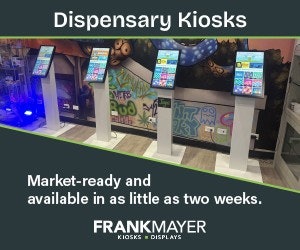featured
The Creature from the Black Leather Lagoon
Published
7 hours agoon

April 18th, 1977. Hollywood, CA.
There was something foul and electric in the air that Monday night at the Starwood. The kind of charge you only find when the floor’s slick with beer and the crowd reeks of leather, cigarettes, and bad choices. The volatile energy of a live wire hissing on a wet dance floor—spitting, sparking, waiting to kill whoever got too close.
The room was a zoo of freaks—burnouts with thousand-yard stares, thrill junkies itching for damage, leather-clad criminals with joints glued to pierced lips, and the occasional college zombie dragging a terrified date into the pit.
The air was swamp-thick: sweat, stale PBR, clove smoke, and always weed. Heavy clouds slithered low across the crowd like cold glycerin—a false floor drenched in Blade Runner-neon—perfumed with Acapulco Gold, Thai Stick, Golden Voice.
Then The Damned hit. And whatever fragile order had been holding the room together dissolved into lawless beauty.
Captain Sensible hunched over his bass like Gollum rigging dynamite. Rat Scabies vanished behind a drum kit that looked ready to detonate. Brian James hacked his guitar like Norman Bates in a thrift-store suit, tie clinging on like a hostage.
And then Vanian. A ghoul from a Hammer Horror reel. He ripped off a vinyl mask to show the real mask beneath: hospital-white skin, slick black hair, eyes wide and vacant like possession. As though the dark itself was being torn inside out. His voice was an exorcism.
They tore into the Stooges’ “I Feel Alright” at double-time, guitars squealing like pigs on the block. Vanian stalked the stage in spasms—half epileptic fit, half black-mass sermon. The stage rattled like a runaway freight train.
You either surrendered to the blitzkrieg or fled to the bar.

Blood in the Pit
That was SoCal punk then. Step into the pit and you stumbled away bruised, soaked, bleeding from god-knows-where, but alive in a way suburbia could never manufacture.
A busted lip was simply proof of purchase. Cig burns on your jacket were rites of passage. Kids got concussed and came back swinging, arms pinwheeling in the pit like upturned helicopters.
Violence wasn’t the point, but it always came with the territory.
By the late ’70s, rock ’n roll had abandoned a generation. The kids who were left out did what the ignored always do: turned basements, ballrooms, and half-legal vet halls into sanctuaries.
And through every room drifted the same fog: weed smoke. Not a garnish, but an essential ingredient. A fifth band member with no name, hanging in the rafters.
Thai Stick joints smoldering to black nails. Acapulco Gold changing hands in parking lots like secret handshakes. Seeds and stems surgically removed with the reverence of an Itamae shaving toro.
Weed was the battery. The voltage in the circuit.
The Outlaw Benefactor
But punk didn’t pay. Five-dollar tickets and photocopied flyers couldn’t keep the lights on. The kids were broke, the bands broke, the clubs hostile. So who kept the ears ringing?
Behind the distortion stood a man most never saw: Gary Tovar—smuggler, outlaw businessman, and the unlikeliest patron saint SoCal punk would ever know.
Born in Los Angeles in 1952, carted off to Huntington Beach at twelve, and dropped into the sun-bleached sprawl where surfers, burnouts, and suburbanites collided, Tovar did the responsible, junior-college circuit—Golden West and Fullerton colleges, the polite conveyor belt of mediocrity—but the truth is he’d already been running his own education for years. By his teens he was a border hustler, smuggling fireworks out of Tijuana with the kind of nerve no textbook could teach.
Soon enough, those extracurricular activities were going to drag him into a new and legendary direction—the kind that starts with a boot on the gas and ends with sirens in the rearview. Where the border was a revolving door and authority was something to be toyed with.
Tovar’s first hit of punk came at Winterland in ’78, watching the Sex Pistols flame out in a blaze of piss and nihilism. But it was his kid sister, Bianca, who pulled back the curtain on what was happening closer to home. Cops were strangling SoCal shows in real time—raids, shutdowns, boots on kids’ necks—and the crackdown only made the bands louder.
To a 20-year-old pirate with cash to burn and an appetite for trouble, that was enough. Punk was worth fronting. Worth pouring gas on until the scene caught fire.
“I saw the culture. I wanted to push it as far as I could,” Tovar said later in an interview with OC Weekly. “Expose it to as many people as possible. There were a lot of good ideas getting a lot of resistance. And I think we won.”
Tovar funneled the money back into the scene. Booking bands no one else would touch. Renting halls respectable promoters wouldn’t risk. Setting fire to his own fortune for the cause.
Punk was the new sound. Weed was the currency. And with Tovar at the wheel, they were building a movement that would mutate into something nobody in that smoke-choked room could have ever imagined.
Zodiacs in the Dark
Gary never looked like a punk promoter. He looked like what he was: a hustler with a gambler’s grin and saltwater on his breath.
He didn’t begin as a kingpin. He began with fireworks—Roman candles smuggled past customs when he was a kid. If you can move rockets, why not reefer? Why not burlap sacks of fat buds hidden under cargo no one bothered to check?
After all, courage comes from the belly. All else is desperation.
By the late ’70s, he was one of California’s biggest cannabis free-traders. Freighters in Asia. Hand-offs at sea. Fishing boats ferrying the goods closer to shore. Zodiacs racing through salty marine layer to unload on deserted stretches of coast. Cloak-and-dagger stuff. Something out of a Len Deighton Cold War novel, except the new enemies weren’t the Soviets—it was the DEA.
Smuggling weed back then was all about faith. Faith in timing, in loyalty, silence. You trusted the ocean to hide you, and your crew to keep their goddamn mouths shut.
Coast Guard spotlights sweeping the water like state-run eyes of Sauron. Helicopters thundering overhead. Smugglers crouched on a beach, sand clinging to sweat, praying the Zodiacs had already melted into the scenery. You learned to live with paranoia, because paranoia kept you breathing.
And yet Tovar kept running loads, more for purpose than for profit. Instead of burying his cash in condos or gold watches, he poured it into punk.
In 1981, when most promoters wouldn’t touch hardcore for fear of cops, fistfights, or trashed venues, Tovar leaned in. Put down deposits on the punk scene. He flew in British acts like GBH and The Adicts, backed Black Flag and Circle Jerks, rented hostile halls like the Olympic Auditorium.
He paid bands fair when others stiffed them. Punk bands didn’t care about the Top 40—they were after the new sound. And Tovar was the quiet backer with deep pockets who wanted to fund their wildest dreams.
Goldenvoice—Tovar’s promotion outfit, named after a Thai strain he claimed “sounded like angels singing in a golden voice”—became the crooked backbone of SoCal punk. Stamped on flyers, whispered about in backrooms.
On paper, Tovar lost millions. In practice, he bought a revolution.
Without his runs of Thai and Acapulco, there’s no TSOL and Shattered Faith at La Casa de la Raza. No Exploited and UK Subs at the Olympic. No Samhain and Necros tearing down the Stardust Ballroom. Nights that would have never made it past soundcheck.
Smoke was the receipt for every busted lip and burned dollar Tovar poured into punk.

The Bill Comes Due
It couldn’t last. Nothing gold does.
March ’91. Dawn. The DEA kicked his door in. Tovar’s double life snapped shut. It didn’t come as a surprise—the bootlegger circuit was already splintering—the war on drugs was at full tilt. Reagan’s mandatory minimums had crystallized the air everyone breathed. ‘Just Say No’ wallpapered over every school in the country, a moral branding iron for an entire generation.
Tovar had gotten too successful. Too visible. Too loud to ignore.
The bill came due.
He pled guilty to trafficking and spent seven years in federal prison. Seven years to replay the reels: fireworks as a teen, freighters in Asia, keeping punk alive one night at a time.
The Velvet Noose
The timing was especially cruel. Just as Goldenvoice was becoming legend—nights that left you bruised but smiling—Tovar lost it. The cuffs clicked, and he handed it over to Paul Tollett and Rick Van Santen.
They kept the name alive. But by the late ’90s, Goldenvoice—the weed-fueled carnival Tovar built—created something its younger self would’ve puked on: Coachella.
The corporate, desert bacchanal of VIP tents and $40 cocktails. From Thai Stick in a Hollywood pit to influencers posing in Indio.
An evolution so cynical it could’ve been a joke.
At the Starwood, you risked a busted nose, maybe a knife fight. At Coachella, you risk sunburn and overpriced rosé. The grit has been scrubbed off, replaced by curated Instagram backdrops and brand activations. The kids once locked out of venues are now locked out by ticket prices.
Goldenvoice may be corporate now, but its roots are resin-soaked. Its name is written in the DNA of a crashing wave that was meant to break once it hit the California coast.
At the core of America’s biggest festival runs a deep current of punk weed lore.

Blood, Smoke & Feedback
Like the plant, Tovar thrived on the margins. Like the plant, he built community where there was none. And like the plant, he was punished for it—caged, stamped a criminal—even as the scene he funded bled ragged into the mainstream.
Now cannabis comes sealed in child-proof plastic. Punk is nostalgia on Spotify, repackaged as background noise for Taco Bell commercials. Coachella is a corporate sandbox of wristbands and influencers elbowing for the best Heineken-sponsored selfie.
But scratch the glossy veneer and Tovar’s fingerprint is still there. You can hear it in the rumble of a hardcore reunion. See it in growers still chasing landrace purity. Smell it in the blunt passed around at the edge of a Turnstile pit. The spirit didn’t die, but it’s forever mutated.
And that’s the pattern. Outlaw culture gets mined, sanitized, sold back to the masses. Jazz clubs. Punk pits. Cannabis farms. The cycle doesn’t stop. The only question is who keeps the spirit alive when the money men move in.
That’s why Gary’s story matters. Not as trivia, but as proof that any culture worth a damn is born underground, sustained by those reckless enough to bankroll it against all odds.
For SoCal punk, weed was the blood.
Music, the drug.
Coachella’s the hangover.
The rest is just smoke.
This article is from an external, unpaid contributor. It does not represent High Times’ reporting and has not been edited for content or accuracy.

Author: mscannabiz.com
MScannaBIZ for all you Mississippi Cannabis News and Information.
You may like
-


Guess What Is Threading Its Way Back To Being Popular
-


39 Attorneys General Tell Federal Lawmakers to Ban Hemp THC Products
-


Now Is the Time to Embrace, Not Abandon, Cannabis Activism
-


No One Is Giving Your Kids Marijuana Edibles in Their Halloween Candy
-


Florida Case On Medical Marijuana Patients’ Gun Rights Is On Hold As Supreme Court Weighs Underlying Issue
-


CULTA Appoints Cannabis Industry Veteran Joseph Andreae as CEO
featured
Guess What Is Threading Its Way Back To Being Popular
Published
38 minutes agoon
October 27, 2025
Guess what is threading its way back to being popular — Gen Z’s surprising new obsession is sew cool.
In a generational twist, young Americans are falling in love with their grandparents’ pastimes. From vinyl records spinning on turntables to typewriters clacking again on dorm desks, Generation Z and Millennials are breathing new life into analog culture. Now, they’re taking nostalgia one step further. You will never guess what is threading its way back to being popular now – sewing machines.
Across TikTok, Instagram, and even in big-box aisles at Costco, sewing is emerging as the latest hands-on hobby to stitch its way back into mainstream life.
RELATED: Immersive Events Redefine Millennial Nights
From gardening and journaling to reviving the look of thrifted 1980s windbreakers, Gen Z has turned “old-fashioned” into “on trend.” This generation values individuality, sustainability and creative expression — all things found in vintage-inspired pursuits. Just as vinyl and Polaroid cameras have made a comeback, sewing fits perfectly into the same ethos: it’s tactile, personal, and proudly non-digital.
The resurgence of hands-on creativity isn’t random. It’s a counterbalance to a world that’s often fast, online and disposable. In a sense, young people aren’t just buying less — they’re making more.

Why Sewing Is Trending Again
1. Crafting identity and self-expression
For many, sewing is a declaration of independence from fast fashion. Customizing or making your own clothing offers a sense of empowerment — a creative outlet says, “I made this.” On social media, this translates into content celebrating originality, individuality and style over mass production.
2. Sustainability and slow fashion
Gen Z and Millennials care deeply about sustainability. Sewing gives them a way to reuse, repurpose and repair, rather than toss and replace. Visible mending — repairing clothing in a way shows off the stitches as part of the design — has become a viral movement on TikTok.
3. Screen-break creativity
With most of life lived online, sewing provides an analog escape. It’s hands-on, calming and meditative — a way to literally disconnect from screens. A recent Fortune article noted many young adults are learning to sew “to get off their phones and save money.”
4. The social media effect
TikTok and Instagram have made sewing trendy, not tedious. Hashtags like #sewingtutorial, #upcycledfashion and #thriftflip are filled with videos showing transformations from thrift-store finds to high-fashion looks. Tutorials and time-lapse reels make the craft feel approachable and rewarding — especially when the finished product is instantly shareable.
RELATED: The Connection Between Country Music And Cannabis
When a major retailer starts stocking modern sewing machines, you know something’s changing. Costco now offers sleek, computerized models like the Singer Heavy Duty 8832 and Brother XR3340, complete with LCD screens, hundreds of stitch patterns, and built-in quilting options. These aren’t your grandmother’s machines — they’re tech-forward tools align with the DIY spirit of younger shoppers.
The fact Costco, known for bulk groceries and electronics, now markets sewing machines signals just how mainstream this revival has become. The craft aisle isn’t just for hobbyists anymore — it’s for creators, side-hustlers and trendsetters.
On Instagram and TikTok, sewing creators are building large, loyal followings. Whether it’s a 20-second video of a thrifted denim jacket getting a new lining or a full tutorial on turning curtains into dresses, sewing content fits perfectly into Gen Z’s creative economy. It’s visually satisfying, shareable, and aspirational in a grounded way — making something from nothing.
Younger users are even reframing the stereotype of sewing as something only grandmothers do. Many proudly show off learning from older relatives while adding a modern twist, connecting generations through thread and fabric.

Author: mscannabiz.com
MScannaBIZ for all you Mississippi Cannabis News and Information.
featured
39 Attorneys General Tell Federal Lawmakers to Ban Hemp THC Products
Published
2 hours agoon
October 27, 2025
The chief law officers from 37 states and two U.S. territories sent a letter Oct. 24 to U.S. House and Senate committee leaders, asking them to stop “dangerous and intoxicating” hemp-derived THC products from being sold and manufactured.
The bipartisan coalition of 39 attorneys general, including those from Puerto Rico and the U.S. Virgin Islands, asked that Congress redefine hemp to close what many have termed an unintended “loophole” in the 2018 Farm Bill, which federally legalized the commercial cultivation of hemp.
Arkansas Attorney General Tim Griffin, along with his counterparts from Indiana (Todd Rokita), Connecticut (William Tong) and Minnesota (Keith Ellison), spearheaded the letter that they signed with other members of the National Association of Attorneys General (NAAG).
“Since the passage of the 2018 Farm Bill, hemp-derived THC products – often more potent than marijuana – have flooded the market due to a misinterpretation of the bill’s language,” Griffin said in a separate press release. “These synthetic cannabinoids, including delta-8, delta-10, THC-O, and others, are being sold in gas stations, convenience stores and online retailers across the country, frequently in packaging purposefully designed to appeal to children.”
The attorneys general sent the letter to the Appropriations and Agriculture committee chairs in both the Senate and House, including Sen. Susan Collins, R-Maine; Sen. John Boozman, R-Ark.; Rep. Tom Cole, R-Okla.; and Rep. Glenn “GT” Thompson, R-Pa.
The letter signers asked the congressional leaders to clarify the definition of hemp through the fiscal 2026 appropriations process or through the farm bill’s pending reauthorization to “leave no doubt that these harmful products are illegal.” The letter signers asked that Congress criminalize the sale and manufacture of intoxicating hemp products.
“Intoxicating hemp-derived THC products have inundated communities throughout our states due to a grievously mistaken interpretation of the 2018 Farm Bill’s definition of ‘hemp’ that companies are leveraging to pursue profits at the expense of public safety and health,” the attorneys general wrote. “Many of these products – created by manufacturers by manipulating hemp to produce synthetic THC – are more intoxicating and psychoactive than marijuana, a Schedule I controlled substance, and are often marketed to minors. Unless Congress acts, this gross distortion of the 2018 Farm Bill’s hemp provision will continue to fuel the rapid growth of an underregulated industry that threatens public health and safety and undermines law enforcement nationwide.”
In addition to the abovementioned states and territories, the letter was also signed by attorneys general from Alabama, Arizona, California, Colorado, Delaware, Georgia, Hawaii, Illinois, Iowa, Kansas, Louisiana, Maine, Maryland, Massachusetts, Mississippi, Missouri, Nebraska, Nevada, New Hampshire, New Mexico, New York, North Carolina, North Dakota, Ohio, Oklahoma, Pennsylvania, Rhode Island, South Carolina, South Dakota, Utah, Vermont, Virginia and Wyoming.
Sen. Mitch McConnell, R-Ky., who championed the federal legalization of commercial hemp cultivation in 2018 as a pathway for Kentucky’s struggling tobacco farmers to benefit from a new agricultural commodity, said in July that he had never intended for the farm bill to “open the door to the sale of unregulated, intoxicating, lab-made, hemp-derived substances with no safety framework.”
That admission came as 27 Senate Appropriations Committee members voted unanimously to approve a 136-page spending bill that included language to ban hemp-derived products containing synthetic compounds and/or quantifiable amounts of THC or THCA, or other cannabinoids that have similar effects on humans or animals. McConnell termed the language as a legislative fix to align with the original intent of the 2018 Farm Bill.
However, Sen. John Hoeven, R-N.D., who chairs the Appropriations Agriculture-Food and Drug Administration (FDA) subcommittee, notified reporters later in July that the hemp THC product language was struck by a manager’s amendment before final passage. The language was pulled because Sen. Rand Paul, R-Ky., threatened to block the entire legislation, which includes more than $27 billion in discretionary funding to support farmers, rural communities and nutrition programs, if the hemp language wasn’t stricken.
Paul, who supports regulation over prohibition, said in September 2024 that he hopes to protect the legalized hemp industry by preventing the federal government “from weighing down our farmers with unnecessary bureaucratic micromanaging.”
As many states have already implemented laws to regulate or ban consumable products containing hemp derivatives, many believe Paul’s pushback at the federal level has only delayed the inevitable. A finalized agriculture spending bill has yet to pass Congress.
“Congress never meant to legalize these products in the 2018 Farm Bill,” the 39 attorneys general wrote. “A proper interpretation of the farm bill’s hemp provision demonstrates that the entire synthetic THC industry rests on a foundation of illicit conduct. Clear direction from Congress is needed to shut down this industry before it metastasizes further into an even greater threat to public safety than it already is.”
While the bipartisan coalition said that the 2018 Farm Bill intended to provide an industrial hemp commodity for the fiber and grain markets, the legislation’s 0.3% delta-9 THC on a dry-weight basis definition established an inadvertent ambiguity that has allowed “bad actors” to exploit the American public with “dangerous drugs” through highly advanced chemical processes.
The attorneys general pointed to the often-used chemical process of converting nonintoxicating CBD from the hemp plant into intoxicating delta-8 THC. The letter writers also pointed to laboratory-created or altered compounds like delta-10 THC, THC-O, THCP and HHC, which are then infused “at high concentrations into a multitude of products that can intoxicate a person as severely as the most potent strains of cannabis sold on the illicit market.”
“In other words,” the attorneys general wrote, “industry actors have nefariously misinterpreted the farm bill’s legalization of low concentrations of hemp-derived delta-9 and the bill’s silence regarding hemp-derived THC products other than delta-9 to claim that the farm bill allows them to produce and sell various synthetic cannabinoids regardless of the chemicals’ potency and psychoactive effects.”
The attorneys general said these “Frankenstein THC” products play by their own set of rules – including age restrictions, labeling standards and testing requirements – and have led to “stark and severe” public health consequences.
In Indiana, where medical and adult-use cannabis programs remain prohibited, total cannabinoid and analog exposures reported to poison control centers increased 41% between 2022 and 2024, with pediatric exposures under age 5 rising 46% and exposures among children aged 6–12 increasing 62%, according to the state’s Department of Health.
Indiana Attorney General Todd Rokita was among the four signers who spearheaded the letter.
State-level efforts to rein in the hemp-derived cannabinoid product marketplace are not enough, according to the bipartisan coalition.
“Such efforts can only lead to an uneven and ineffectual patchwork of bans and regulations that differ from state to state and will not stop the flood of mail-order THC products from streaming through interstate commerce,” they wrote. “Congress must act to salvage the 2018 Farm Bill’s laudable legalization of commercial hemp from the psychoactive hemp industry’s spoliation of the bill’s hemp provision.”

Author: mscannabiz.com
MScannaBIZ for all you Mississippi Cannabis News and Information.
featured
Now Is the Time to Embrace, Not Abandon, Cannabis Activism
Published
3 hours agoon
October 27, 2025
This article originally appeared in High Times Magazine’s 50th Anniversary Print Issue. Order yours here and get it delivered to your door.
Political and societal changes rarely occur organically. They only happen when advocates agitate for them.
For over five decades, NORML and its grassroots supporters have advocated for ending the criminalization, discrimination, and stigmatization of cannabis consumers. We have been deliberate and diligent in our efforts to change the way people talk and think about the marijuana plant and those who consume it.
It’s been – and it remains – an uphill battle. Our movement challenges powerful special interests, like law enforcement. Our work is deeply underfunded. Our advocates are often underrepresented in the mainstream media and in the political arena. But we are winning nonetheless because our message is irrefutable: It makes no sense from a public health perspective, a fiscal perspective, or a moral perspective to arrest, prosecute, and incarcerate adults who choose to responsibly consume a substance that is objectively safer than either alcohol or tobacco.
Also read: Want Clean, Safe Cannabis? Home Grow And Legal Access Are The Answer
At the time of NORML’s founding, only about one in ten Americans believed that cannabis should be legal. Today, 70 percent of Americans support legalization. There are several reasons for this dramatic shift in public opinion. One: the devastating effects of prohibition – including the arrest of over 30 million Americans, disproportionately young and poor people, for violating marijuana possession laws – have been laid bare for all to see. Two: the successes of legalization – including the public health benefits provided by the growing acceptance of medical cannabis and the economic benefits provided by regulated markets – have become impossible to deny. As more jurisdictions have moved to legalize the plant for either therapeutic or recreational purposes, public support for these policies has increased exponentially. In short, the more the public has first-hand experience with legalization, the more they like it.
But just because we have won the hearts and minds of the public doesn’t mean that we have successfully won the legalization battle. In fact, in some respects, it’s made our fight that much harder.
Many supporters now believe, falsely, that nationwide legalization is some sort of fait accompli and therefore, there’s no longer a need for grassroots advocacy. This perception is woefully incorrect. Our political and cultural opponents have not gone away. In many cases, they have regrouped and re-strategized. Knowing that their side has lost the war of ideas, they’ve pivoted to targeting democracy itself – at times attacking and undermining the ballot initiative process, in other instances, overturning marijuana-related election results they disapprove of. In jurisdictions where cannabis is legal, they are chipping away at consumers’ hard-won freedoms by lobbying for arbitrary potency limits (which would re-criminalize certain cannabis products as well as those who produce and consume them), pushing for artificially high sale taxes, and calling on cities and towns to impose bans on marijuana-related businesses.
Also read: Debunking Pot Potency Hysteria: The Truth About ‘Super-Strong’ Weed
Others presume that the corporate cannabis industry can sufficiently and successfully carry our movement to the next level. This is wishful thinking. While some players in the commercial cannabis space do provide limited financial support for grassroots activism, most cannot or do not. More concerningly, the interests of the cannabis industry do not always align with those of consumers. Issues that matter most to the cannabis community, such as securing home cultivation rights, expunging past criminal convictions, ending workplace discrimination, and strengthening parental rights, often get short shrift from industry players – who are far more likely to utilize their resources to lobby for changes in corporate tax codes and industry-specific regulations. In this vacuum, it is critical that activist groups like NORML and other grassroots organizers ensure that consumers’ voices, rather than corporate interests, remain prominent in the ongoing public policy debate. After all, there is no cannabis industry without cannabis consumers.
Finally, it goes without saying that our movement’s objectives are not met until federal cannabis prohibition is repealed. Despite most states having now legalized cannabis, all these policies – and more importantly, those who provide and consume cannabis under these laws – are in violation of federal law and remain in jeopardy of potential federal prosecution. This fact won’t change until the cannabis plant is removed from the federal Controlled Substances Act entirely. Reclassifying cannabis to a lower status, like Schedule III, is not a sufficient long-term solution and, in fact, it will perpetuate the growing divide between state and federal marijuana policies. For states to truly legalize cannabis without the threat of undue federal interference, the government must abandon its long-standing ‘Flat Earth’ policies once and for all. In short, the need for grassroots consumer-driven advocacy is more important than ever. Now is not the time for the cannabis community to rest on the laurels of its past successes or to presume that someone else is going to finish the job. Historically, it’s been the efforts of dedicated advocacy groups like NORML (along with longtime ally High Times) that have represented our culture and demanded that it be recognized and respected. Ultimately, it is this same activist community that must continue to lead this fight, and it is our community that will ultimately liberate the cannabis plant and cannabis consumers from the shackles of prohibition.
This article originally appeared in High Times Magazine’s 50th Anniversary Print Issue. Order yours here and get it delivered to your door.
Paul Armentano is the Deputy Director of the National Organization for the Reform of Marijuana Laws, America’s oldest cannabis consumers’ lobby. To become a member of NORML or to support NORML’s efforts, please consider making a donation here.
Photo by Luis Quintero on Unsplash

Author: mscannabiz.com
MScannaBIZ for all you Mississippi Cannabis News and Information.

Guess What Is Threading Its Way Back To Being Popular

39 Attorneys General Tell Federal Lawmakers to Ban Hemp THC Products

Now Is the Time to Embrace, Not Abandon, Cannabis Activism

No One Is Giving Your Kids Marijuana Edibles in Their Halloween Candy

Florida Case On Medical Marijuana Patients’ Gun Rights Is On Hold As Supreme Court Weighs Underlying Issue

CULTA Appoints Cannabis Industry Veteran Joseph Andreae as CEO

The Creature from the Black Leather Lagoon

Cannabis industry case challenging prohibition hits Supreme Court (Newsletter: October 27, 2025)

I Worked a Day as a Budtender in Brooklyn: Here’s What I Learned

Trump’s ‘Stupid’ Drug War Killings Put Military In Untenable Position, Former GOP Attorney General Of Idaho Says (Op-Ed)

Oregon Officials Seek To Dismiss Psilocybin Access Lawsuit From Homebound Patients

South Dakota Medical Marijuana Advocates Alarmed After Lawmakers Give Prohibitionists A Platform

What Levi Strauss Can Teach Us About Craft and Cannabis

Michigan Lawmakers Consider Bills To Change Legal Marijuana Possession Limits And Alter Industry Disciplinary Rules

Bad Stoner Horror: The 10 Worst-Rated 420 Scary Movies

Vee the Traveling Cannabis Writer Unveils First Book in Cannabis Legacy Series – Ganjapreneur

[Video] G Herbo: Snoop Rolled My Blunt and Let Me Hit It, Smoking A Zip a Day, Chicago Munchies (Weird) and What’s Next

Marijuana Companies Ask U.S. Supreme Court To Take Up Case Challenging Constitutionality Of Federal Prohibition

The Odds Of The Feds Making A 2025 Cannabis Change

The Epic High Times Cannabis Cup Journey, From Amsterdam to the Empire State

GOP Senator Pushes To Study—Rather Than Ban—Hemp Products, As State Attorneys General Call For THC Prohibition

Happy International Champagne Day – The Fresh Toast

Maryland Police Want To Watch You Smoke Weed: Free Munchies and Ride Home Included

More Americans Now Use Marijuana Than Smoke Cigarettes, New Study Shows

Alert: Department of Cannabis Control updates data dashboards with full data for 2023

Connecticut Appoints The US’s First Cannabis Ombudsperson – Yes there is a pun in there and I’m Sure Erin Kirk Is Going To Hear It More Than Once!

5 best CBD creams of 2024 by Leafly

Recreational cannabis on ballot for third time in South Dakota

EU initiative begins bid to open access to psychedelic therapies
New Study Analyzes the Effects of THCV, CBD on Weight Loss

Free delta-9 gummies from Bay Smokes

5 best autoflower seed banks of 2024 by Leafly

Discover New York’s dankest cannabis brands [September 2024]

May 2024 Leafly HighLight: Pink Runtz strain

Press Release: CANNRA Calls for Farm Bill to Clarify Existing State Authority to Regulate Hemp Products

5 best THC drinks of 2024 by Leafly

Local medical cannabis dispensary reacts to MSDH pulling Rapid Analytics License – WLBT

6 best CBD gummies of 2024 by Leafly

Curaleaf Start Process Of Getting Their Claws Into The UK’s National Health System – With Former MP (Resigned Today 30/5/24) As The Front Man

Horn Lake denies cannabis dispensary request to allow sale of drug paraphernalia and Sunday sales | News

5 best delta-9 THC gummies of 2024 by Leafly

The Daily Hit: October 2, 2024

Mississippi city official pleads guilty to selling fake CBD products

Nevada CCB to Accept Applications for Cannabis Establishments in White Pine County – “Only one cultivation and one production license will be awarded in White Pine County”

5 best THCA flower of 2024 by Leafly

Weekly Update: Monday, May 13, 2024 including, New Guide for Renewals & May Board meeting application deadline

6 best hemp pre-rolls of 2024 by Leafly

PRESS RELEASE : Justice Department Submits Proposed Regulation to Reschedule Marijuana
Trending
-

 California Cannabis Updates1 year ago
California Cannabis Updates1 year agoAlert: Department of Cannabis Control updates data dashboards with full data for 2023
-

 Breaking News1 year ago
Breaking News1 year agoConnecticut Appoints The US’s First Cannabis Ombudsperson – Yes there is a pun in there and I’m Sure Erin Kirk Is Going To Hear It More Than Once!
-

 best list1 year ago
best list1 year ago5 best CBD creams of 2024 by Leafly
-

 Business1 year ago
Business1 year agoRecreational cannabis on ballot for third time in South Dakota
-

 Business1 year ago
Business1 year agoEU initiative begins bid to open access to psychedelic therapies
-

 cbd1 year ago
cbd1 year agoNew Study Analyzes the Effects of THCV, CBD on Weight Loss
-

 Bay Smokes1 year ago
Bay Smokes1 year agoFree delta-9 gummies from Bay Smokes
-

 autoflower seeds1 year ago
autoflower seeds1 year ago5 best autoflower seed banks of 2024 by Leafly


